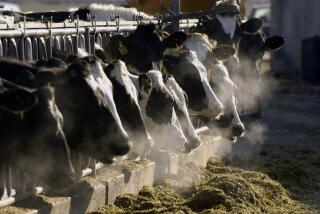Minnesota says raw milk makes more people sick than recognized
As the movement to relax regulations on raw milk seems to be gaining steam, health officials in Minnesota warned Wednesday that raw milk could be making more people sick than previously recognized, based on a 10-year study. They estimated that more than 17% of the state’s residents who drank raw milk got sick.
Raw milk long has been identified as a source of foodborne illness outbreaks, but it is also responsible for uncounted sporadic illnesses, the Minnesota officials said. Raw milk has not been subject to pasteurization, a heating process that kills bacteria. Those bacteria, including salmonella and campylobacter, can make people sick with symptoms such as diarrhea, stomach cramps and fever.
Advocates of raw milk say it tastes great and has health benefits, and farm families have been traditional consumers. Thirty states permit the sale of raw milk under some conditions, including Minnesota and California.
“Raw milk consumers, potential consumers and policy makers who might consider relaxing regulations regarding raw milk sales should be educated regarding illnesses associated with raw milk consumption,” the Minnesota Department of Health study noted.
From 1998 to 2008, the U.S. Centers for Disease Control and Prevention documented 85 outbreaks from consumption of raw milk or cheese made from raw milk. A total of 1,614 reported illnesses, 187 hospitalizations and two deaths were reported from the outbreaks.
Sporadic illnesses -- those not part of an outbreak -- far outnumber the instances counted in outbreaks, and many illnesses go unreported, the Minnesota officials wrote. That means that the incidence of illness is higher than recognized, they said.
Analysis of data collected in Minnesota from 2001 to 2010 showed that 3.7% of people who reported foodborne gastrointestinal infections had consumed raw milk, with children disproportionately affected and many people drinking raw milk on their own or relatives’ farms, the Minnesota officials said.
The officials analyzed 14,339 cases of foodborne illness, and found that 3.7% had consumed raw milk -- mostly from cows -- during the time they were exposed to the bacteria. Seventy of them had to be hospitalized, for an average of three days, and an 11-month-old child died. Of the 530 people, 377 told officials where the milk came from. Almost half of them got it from their own or a relative’s farm.
The Minnesota officials applied multipliers to account for under-diagnosis and estimated that over the 10 years, 20,502 people got sick with sporadic illnesses after drinking raw milk. Further, they estimated that 118,843 people drink raw milk in a given week in the state.
That led them to conclude that an estimated 17.3% of raw milk drinkers in Minnesota may have become sick from a pathogen associated with raw milk. It’s possible, the officials said, that people can get sick from direct contact with the cows, rather than just the milk, but they consider that unlikely for most people.
In California, the Department of Public Health requires a warning label on raw dairy products that says they “may contain disease-causing microorganisms. Persons at highest risk of disease from these organisms include newborns and infants; the elderly; pregnant women; those taking corticosteroids, antibiotics or antacids; and those having chronic illnesses or other conditions that weaken their immunity.”
ALSO:
Not only getting better in the ICU
There’s not just one way to be depressed







